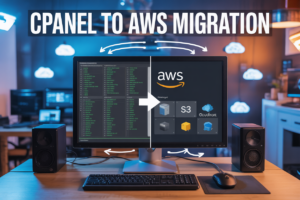Amazon Bedrock transforms how businesses deploy generative AI AWS solutions by removing the complexity of managing infrastructure and foundation models. This comprehensive guide targets developers, AI engineers, and technical decision-makers who want to build scalable AI applications without the heavy lifting of model training or server management.
You’ll discover how Amazon Bedrock’s serverless AI solutions let you access powerful foundation models Amazon through simple API calls, dramatically reducing development time and operational overhead. We’ll walk through the platform’s key benefits for AI model deployment AWS, including automatic scaling, pay-per-use pricing, and enterprise-grade security features.
This tutorial covers three essential areas: first, we’ll explore the range of foundation models available and help you choose the right one for your use case. Second, you’ll learn practical Bedrock AI implementation strategies through building your first application from scratch. Finally, we’ll dive into advanced techniques for optimizing performance and managing costs when scaling your generative AI solutions in production environments.
Understanding Amazon Bedrock’s Generative AI Capabilities
Pre-trained foundation models from leading AI companies
Amazon Bedrock offers access to cutting-edge foundation models from industry leaders like Anthropic, AI21 Labs, Cohere, and Meta. These pre-trained models handle text generation, conversation, code creation, and image processing without requiring custom training. You can choose from Claude for advanced reasoning, Jurassic for multilingual tasks, Command for enterprise applications, and Llama for open-source flexibility.
Serverless architecture eliminates infrastructure management
The serverless AI solutions approach means you never worry about provisioning servers, managing clusters, or scaling compute resources. Amazon Bedrock automatically handles all infrastructure requirements, allowing your team to focus on building applications rather than maintaining hardware. This architecture scales seamlessly from prototype to production, handling traffic spikes and quiet periods without manual intervention.
Built-in security and compliance features
Security comes standard with enterprise-grade encryption, VPC support, and AWS Identity and Access Management integration. Amazon Bedrock maintains SOC, HIPAA, and other compliance certifications while providing data residency controls. Your prompts and generated content stay within your AWS environment, ensuring sensitive information never leaves your security perimeter. Role-based access controls and audit logging provide complete visibility into AI usage patterns.
Pay-per-use pricing model reduces operational costs
The pay-per-use pricing structure charges only for actual API calls and tokens processed, eliminating upfront costs and idle resource expenses. You can experiment with different foundation models Amazon offers without long-term commitments or minimum usage requirements. This model scales cost-effectively with your application growth, making generative AI AWS solutions accessible for startups and enterprises alike while providing predictable cost management.
Key Benefits of Scaling AI Applications with Amazon Bedrock
Rapid deployment without model training requirements
Amazon Bedrock eliminates the traditional barriers of AI development by providing pre-trained foundation models ready for immediate use. Organizations can skip months of data collection, model training, and fine-tuning processes that typically consume significant resources. Instead of building machine learning expertise from scratch, development teams can access powerful generative AI capabilities through simple API calls. This approach transforms AI implementation from a complex, resource-intensive project into a straightforward integration task that can be completed in days rather than months.
Automatic scaling to handle variable workloads
The serverless architecture of Amazon Bedrock automatically adjusts to demand fluctuations without manual intervention or capacity planning. During peak usage periods, the platform seamlessly scales up to handle thousands of concurrent requests, while scaling down during low-traffic times to optimize costs. This elastic scaling capability ensures consistent performance regardless of whether you’re serving ten users or ten thousand. Development teams no longer need to worry about infrastructure provisioning, load balancing, or performance bottlenecks that traditionally plague AI applications under varying workloads.
Enterprise-grade security and data privacy protection
Amazon Bedrock implements comprehensive security measures that meet strict enterprise compliance requirements and data protection standards. All data transmitted to and from foundation models remains encrypted in transit and at rest, with no customer data used for model training or improvement. The platform provides detailed audit logs, identity and access management controls, and supports VPC endpoints for secure private connectivity. Organizations can deploy scalable AI applications while maintaining full control over their sensitive information and meeting regulatory compliance requirements across industries like healthcare, finance, and government.
Essential Foundation Models Available on Amazon Bedrock
Text generation models for content creation and automation
Amazon Bedrock offers powerful text generation foundation models including Claude, Llama, and Titan models that excel at creating marketing copy, technical documentation, and automated content workflows. These models handle everything from blog posts and product descriptions to email campaigns and social media content. The serverless AI solutions integrate seamlessly with existing AWS services, enabling businesses to automate content creation at scale while maintaining consistent brand voice and quality standards across all generated materials.
Code generation capabilities for software development
Foundation models Amazon provides through Bedrock include specialized code generation models like CodeWhisperer and Claude that accelerate software development cycles. These AI model deployment AWS solutions generate clean, functional code in multiple programming languages, debug existing applications, and create comprehensive documentation. Development teams can leverage these generative AI AWS capabilities to reduce coding time by up to 50%, streamline code reviews, and maintain consistent coding standards across large-scale projects.
Image and multimodal models for creative applications
Bedrock AI implementation extends beyond text with advanced image generation models like Stable Diffusion and Titan Image Generator that create stunning visuals for marketing campaigns, product mockups, and creative projects. These multimodal models combine text and image understanding to generate contextually relevant artwork, edit existing images, and create variations based on specific brand guidelines. Creative teams can rapidly prototype visual concepts and scale content production without traditional design bottlenecks.
Conversational AI models for customer service enhancement
Scalable AI applications on Amazon Bedrock include conversational models that transform customer service experiences through intelligent chatbots and virtual assistants. These foundation models understand context, maintain conversation history, and provide personalized responses across multiple channels. Customer service teams can deploy these AWS machine learning solutions to handle routine inquiries, escalate complex issues appropriately, and maintain 24/7 support availability while reducing operational costs and improving customer satisfaction scores.
Building Your First Scalable AI Application
Setting up AWS credentials and Bedrock access permissions
Getting started with Amazon Bedrock requires proper AWS credentials configuration through IAM roles and policies. Create a dedicated IAM user with BedrockFullAccess permissions, then configure your AWS CLI with access keys. For production environments, use IAM roles attached to EC2 instances or Lambda functions instead of hardcoded credentials. Enable model access through the AWS Console’s Bedrock service page, as foundation models require explicit activation before API usage.
Choosing the right foundation model for your use case
Amazon Bedrock offers diverse foundation models from leading AI companies like Anthropic’s Claude, Amazon’s Titan, and Meta’s Llama. Text generation tasks work best with Claude or Titan Text models, while image creation requires Titan Image Generator or Stability AI’s models. Consider factors like response latency, token limits, and pricing when selecting models. Claude excels at conversational AI and complex reasoning, while Titan models provide cost-effective solutions for basic text processing and embeddings generation.
Implementing API calls and handling responses
Bedrock API integration uses standard AWS SDKs with the InvokeModel operation for synchronous requests and InvokeModelWithResponseStream for streaming responses. Structure your requests with model-specific parameters like temperature, max tokens, and stop sequences. Handle responses by parsing JSON payloads that contain generated text, token usage statistics, and model metadata. Implement proper error handling for throttling, model unavailability, and content filtering violations to ensure robust applications.
Configuring scaling parameters for optimal performance
Optimize scalable AI applications through strategic parameter tuning and infrastructure configuration. Set appropriate batch sizes for concurrent requests while respecting model-specific rate limits. Use auto-scaling groups for EC2-based deployments or configure Lambda concurrency limits for serverless architectures. Implement connection pooling and request queuing to manage traffic spikes effectively. Monitor CloudWatch metrics like invocation latency and error rates to fine-tune scaling thresholds and ensure consistent performance across varying workloads.
Advanced Implementation Strategies for Production Environments
Multi-model Orchestration for Complex Workflows
Production-grade generative AI applications often require multiple Amazon Bedrock foundation models working together to handle complex business scenarios. You can create sophisticated workflows by chaining different models – using Claude for reasoning tasks, Stable Diffusion for image generation, and Titan for embeddings. AWS Step Functions provides the perfect orchestration layer, allowing you to build resilient pipelines that automatically handle retries, error handling, and conditional logic. This approach lets you leverage each model’s strengths while maintaining cost efficiency through selective model invocation.
Custom Fine-tuning Techniques for Specialized Requirements
Amazon Bedrock’s fine-tuning capabilities enable you to adapt foundation models to your specific domain without the infrastructure complexity of traditional ML training. Start with smaller datasets (1,000-10,000 examples) to validate your approach before scaling up. Use Amazon SageMaker Ground Truth for efficient data labeling, and implement continuous evaluation metrics to track model performance against your business objectives. The serverless nature of Bedrock fine-tuning means you only pay for actual training time, making experimentation cost-effective while delivering models tailored to your industry’s unique language patterns and requirements.
Integration with Existing AWS Services and Databases
Seamless integration transforms Amazon Bedrock from a standalone AI service into a powerful component of your existing architecture. Connect directly to Amazon RDS, DynamoDB, or Amazon S3 for real-time data retrieval and context injection. Use Amazon API Gateway to expose your AI capabilities as RESTful endpoints, while AWS Lambda functions handle preprocessing and postprocessing logic. Implement Amazon CloudWatch for comprehensive monitoring and AWS IAM for granular access control. This integration strategy ensures your generative AI applications can access enterprise data securely while maintaining the scalability and reliability your production environment demands.
Optimizing Performance and Managing Costs at Scale
Request Batching and Caching Strategies
Smart batching transforms expensive individual API calls into cost-effective bulk operations. Group similar requests together and send them simultaneously to Amazon Bedrock, reducing overhead and improving throughput. Implement response caching for frequently requested outputs – store generated content in Amazon ElastiCache or S3 for rapid retrieval. This approach cuts costs dramatically while speeding up response times for common queries.
Model Selection Based on Latency and Accuracy Requirements
Different foundation models Amazon offers serve distinct performance profiles. Claude Instant delivers lightning-fast responses for simple tasks, while Claude v2 provides superior accuracy for complex reasoning. Titan models excel at embedding tasks with balanced performance. Match your use case requirements – chatbots need speed, content generation demands quality, and search applications require precise embeddings.
Monitoring Usage Patterns and Cost Optimization Techniques
Amazon CloudWatch reveals critical usage patterns across your generative AI AWS deployment. Track token consumption, request frequency, and model performance metrics to identify optimization opportunities. Set up custom dashboards showing cost per interaction and model efficiency ratios. Use AWS Cost Explorer to analyze spending trends and implement tagging strategies for detailed cost allocation across different application features.
Setting Up Alerts and Automated Scaling Policies
Configure CloudWatch alarms to trigger when costs exceed predefined thresholds or when performance metrics degrade. Create automated responses using Lambda functions that can switch between models based on load patterns. Implement circuit breakers that gracefully handle API limits and errors. Set budget alerts through AWS Budgets to prevent unexpected charges and establish spending controls for your Bedrock AI implementation.
Amazon Bedrock transforms how businesses approach generative AI by removing the complexity of building and scaling AI applications from scratch. With access to multiple foundation models, automatic scaling capabilities, and AWS’s robust infrastructure, companies can focus on creating value instead of wrestling with technical hurdles. The platform’s pay-as-you-go model and built-in optimization tools make it easier to control costs while delivering powerful AI experiences to users.
Ready to bring your AI ideas to life? Start with a simple proof of concept using one of Bedrock’s foundation models, then gradually scale up as you learn what works best for your specific use case. The beauty of Amazon Bedrock lies in its ability to grow with your needs – whether you’re building a chatbot for customer service or developing complex content generation workflows, the platform has the tools and flexibility to support your journey from prototype to production.




















